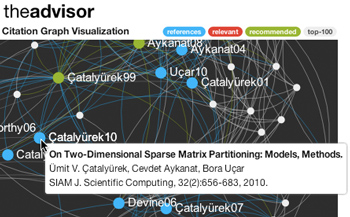Citation Recommendation
Direction Awareness in Citation Recommendation
Onur Kucuktunc, Erik Saule, Kamer Kaya, Umit V. Catalyurek
Abstract - Literature search is an important part of academic research. The increase in the number of published papers each year makes manual search inefficient, hence, automatic methods must be devised. Unfortunately, traditional search engines use keyword-based approaches to solve the search problem which are prone to ambiguity and synonymity. This paper focuses on the problem of extending a set of references using the citation relations between the documents. In particular, we introduce the class of direction-aware algorithms which weight the importance of incoming and outgoing edges of the citation graph differently based on user preferences. Using such an algorithm, the user can easily focus her search toward recent developments or traditional papers. We present two direction-aware algorithms and show that they are better suited at solving the problem at hand than state-of-the-art recommendation methods. One of these algorithms is currently deployed in a publicly available web-service called theadvisor.
N/A
PDF
literature search, graph, random walks, paper
recommendation, web service
Fast Recommendation on Bibliographic Networks
Onur Kucuktunc, Kamer Kaya, Erik Saule, Umit V. Catalyurek
Abstract - Graphs and matrices are widely used in algorithms for social network analyses. Since the number of interactions is much less than the possible number of interactions, the graphs and matrices used in the analyses are usually sparse. In this paper, we propose an efficient implementation of a sparse-matrix computation which arises in a publicly available citation recommendation service called theadvisor. The recommendation algorithm uses a sparse matrix generated from the citation graph. We observed that the nonzero pattern of this matrix is highly irregular and the computation suffers from high number of cache misses. We propose techniques for storing the matrix in memory efficiently and reducing the number of cache misses. Experimental results show that our techniques are highly efficient on reducing the query processing time which is highly crucial for a web service.
10.1109/ASONAM.2012.82
PDF
citation recommendation, social network analysis, sparse matrices, hypergraphs, cache locality
Supplementary Material
Recommendation on Academic Networks using Direction Aware Citation Analysis
Onur Kucuktunc, Erik Saule, Kamer Kaya, Umit V. Catalyurek
Abstract -
The literature search has always been an important part of an academic
research. It greatly helps to improve the quality of the research
process and output, and increase the efficiency of the researchers in
terms of their novel contribution to science. As the number of published
papers increases every year, a manual search becomes more exhaustive even
with the help of today's search engines since they are not specialized for
this task. In academics, two relevant papers do not always have to share
keywords, cite one another, or even be in the same field. Although a
well-known paper is usually an easy pray in such a hunt, relevant papers
using a different terminology, especially recent ones, are not obvious to
the eye.
In this work, we propose paper recommendation algorithms by using the
citation information among papers. The proposed algorithms are direction
aware in the sense that they can be tuned to find either
recent or traditional papers. The algorithms require a set of papers
as input and recommend a set of related ones. If the user wants to
give negative or positive feedback on the suggested paper set, the
recommendation is refined. The search process can be easily guided in
that sense by relevance feedback. We show that this slight guidance
helps the user to reach a desired paper in a more efficient way. We
adapt our models and algorithms also for the venue and reviewer
recommendation tasks. Accuracy of the models and algorithms is
thoroughly evaluated by comparison with multiple baselines and
algorithms from the literature in terms of several objectives specific
to citation, venue, and reviewer recommendation tasks. All of these
algorithms are implemented within a publicly available web-service
framework (theadvisor)
which currently uses the data from DBLP
and CiteSeer to construct the
proposed citation graph.
arXiv:1205.1143
PDF
literature search, graph, random walks, paper
recommendation, web service
